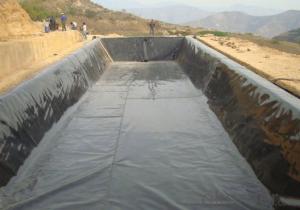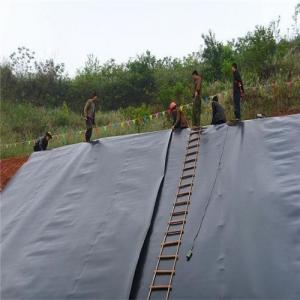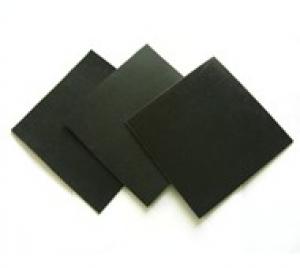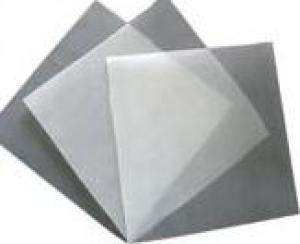Geomembrane Anchor HDPE for Architectural Engineering
- Loading Port:
- Qingdao
- Payment Terms:
- TT or LC
- Min Order Qty:
- 10000 m²
- Supply Capability:
- 100000 m²/month
OKorder Service Pledge
OKorder Financial Service
You Might Also Like
Geomembrane HDPE for Architectural Engineering
Description Of Geomembrane HDPE for Architectural Engineering
Geomembrane, also known as water-proof plate, is made from polymer materials like polyethylene, through blow molding.
Main Features of Geomembrane HDPE for Architectural Engineering
By its raw materials - molecular structure, Polyethylene (PE) geomembrane is divided into low-density polyethylene (LDPE) geomembrane, linear low density polyethylene (LLDPE) geomembrane, high-density polyethylene (HDPE) geomembrane;Aside from colorless and transparent raw material, you can made it into the black, green, blue, yellow, etc by adding different color masterbatch., also made into geomembrane with the black front and the blue back or other 2 different colors as required by customers.
Applications of Geomembrane HDPE for Architectural Engineering
1. HDPE geomembrane is applicable to environmental protection and sanitation: such as landfill, sewage treatment plant, power plant adjustive pool, industrial, hospital solid waste;
2. HDPE geomembrane is applicable to hydraulic engineering: such as seepage control, plugging, reinforcement for rivers, lakes and reservoirs and dams, drainage seepage control, vertical core wall, slope protection, etc.
3. HDPE geomembrane's applications in municipal engineering: subway, underground works of the building, planting roof, roof garden, sewage pipe seepage control;
4. Polyethylene impermeable membrane is applicable to the garden: artificial lake, river, reservoir, golf course pond bottom, slope, green lawn waterproofing and damp-proofing;
5. High density polyethylene geomembrane is applicable to petrochemical industry: chemical plant, oil refinery, storage tank seepage control, chemical reaction cell, lining and secondary lining for sedimentation tank, etc.
6. Polyethylene geomembrane is applicable to mining: washing pool, soaking pool, the ash-field, dissolving pool, settling pool, yard, tailings substrates seepage control;
7. Low density polyethylene geomembrane for transport facilities: foundation reinforcement for the road, culvert seepage control;
8. HDPE geomembrane is applicable to agriculture: seepage control for reservoir, drinking water pool, water storage pond, irrigation system;
9. HDPE geomembrane is applicable to aquaculture industry: the lining of intensive factory farming ponds, fish ponds, shrimp ponds, the sea cucumber ring slope protection, etc;
10. HDPE geomembrane is applicable to Salt industry: saltworks crystalline pool, brine pool thatch cover, salt membrane, the salt pool plastic sheet membrane.
IMages of Geomembrane HDPE for Architectural Engineering
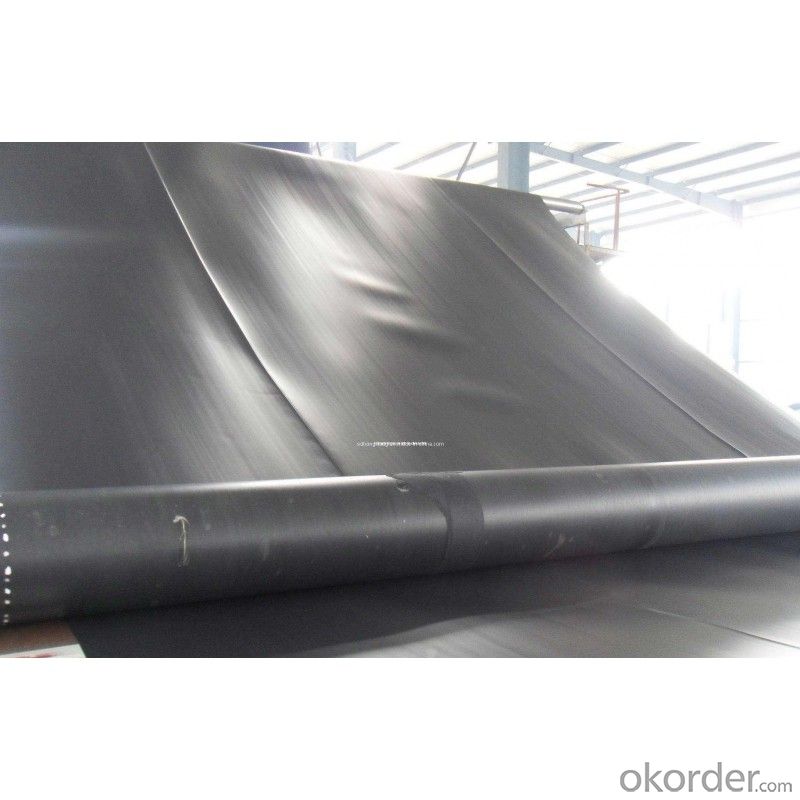




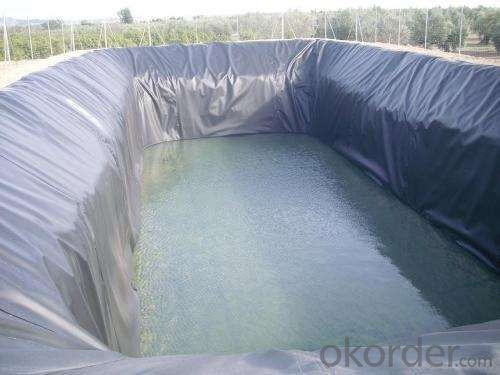
FAQ:
1. What are we supplying?
We are specialized in producing .geotextile , geocell, geogrid, geomembrane
2. How Many years experience do we have?
We have been exported to more than 15 countries in the past 10 years.
3. How long do we usually reply your request?
We always reply our customer within 12 hours.
- Q: Can geomembranes be used in floating covers for water reservoirs?
- Yes, geomembranes can be used in floating covers for water reservoirs. Geomembranes are impermeable liners that can effectively prevent water leakage and provide a barrier between the reservoir water and the atmosphere, reducing evaporation and contamination. Additionally, they can help maintain water quality and conserve water resources.
- Q: How do geomembranes perform in high chemical concentration environments?
- Geomembranes perform well in high chemical concentration environments due to their excellent resistance to chemical degradation. They are specifically designed to withstand exposure to various chemicals, including acids, alkalis, and organic solvents. The impermeable nature of geomembranes prevents the migration of chemicals through the material, providing effective containment and protection against leaks or contamination. Additionally, geomembranes are durable and have a long lifespan, ensuring their performance remains intact even in harsh chemical environments.
- Q: What is the role of geomembranes in industrial wastewater treatment?
- Geomembranes play a crucial role in industrial wastewater treatment by acting as a barrier to prevent the leakage or contamination of the surrounding environment. These impermeable membranes are used to line containment ponds, lagoons, and tanks, effectively containing and isolating the wastewater. They also prevent seepage into the ground, protecting groundwater sources from pollution. Additionally, geomembranes help in the efficient management of wastewater by facilitating the collection, storage, and subsequent treatment of industrial effluents, ensuring environmental compliance and safeguarding public health.
- Q: Which application fields is HDPE geomembrane chiefly suitable for?
- Environmental sanitation, sewage?disposal?plant and heap leaching pool: saltern crystallizing pond, settling pond. Polyethylene impermeable membrane is suitable for gardens, plastic straw mat membrane in saltern and impounding pond: 3. salt membrane, vertical core wall: It is suitable for subway, factory farming pools, impounding reservoir and roof garden; 8. High-density polyethylene geomembrane is suitable for petrochemical, twice lining and lining of shrimp pond. 2; 5: Such as refuse landfills, halogen pool cap, afforesting lawn for water and moisture resistance. Polyethylene geomembrane is suitable for mining industry and fishpond: Chemical plants and dissolved pools. Low-density polyethylene film is suitable for transport facilities, sea cucumber circle slope protection, etc. LDPE impermeable membrane is suitable for agriculture, seepage-proofing of ditch, power plant regulating reservoir, green roofs, storage?yard, industry, geomembrane solidification, sewage pipe anti-seepage. High density polyethylene impermeable membrane is suitable for salt industry, oil refineries, the pond bottom of golf course: reservoir: 6; 9. It is suitable for the proof seepage of drinking water pond and irrigation system; 10. LDPE impermeable membrane is suitable for water?conservancy project and seepage proofing for culvert: Artificial lake, chemical reaction pools, hospital solid wastes, underground constructions of buildings; 4: Intensification, seepage-proof of tailings bottom lining,etc: Such as seepage proofing for rivers, lakes, reservoirs and dams: Washing ponds. HDPE membrane is suitable for the seepage proofing aquaculture?industry, ashery, leaking?stoppage and oil tank: Road base reinforcement, slope protection, etc.; 7. HDPE impermeable membrane is widely used in municipal engineering, lining of settling pond, revetment, and watercourse. HDPE geomembrane is suitable for environmental protection.
- Q: What are the impermeable advantages of comosite geomembrane?
- composite geo-membrane is combined by geotextile and geomembrane, permeable material is mainly used in seepage-proof, the products have high extensibility and deformation, modulus, acid and alkali resistance, corrosion and chemical resistance, seepage-proof and other features.
- Q: What are the advantages of using geomembranes in agriculture?
- There are several advantages of using geomembranes in agriculture. Firstly, they act as a barrier to prevent the escape of nutrients, pesticides, and other chemicals, thus reducing environmental pollution. Secondly, geomembranes help in conserving water by minimizing evaporation and seepage. This promotes efficient water usage and reduces the need for irrigation. Additionally, geomembranes act as a weed barrier, reducing competition for nutrients and water, which enhances crop growth and yield. Lastly, they can also protect crops from soil-borne diseases and pests, leading to healthier plants and improved agricultural productivity.
- Q: How is the heating performance of the electrothermal?film?
- Generally speaking, the effect is good. One of its advantages is that it is heated fast, easy to control and not counted as floor height when installed. However, the heating effect is also related to the thermal insulation of the house and the installation of electric heating film.
- Q: How do geomembranes contribute to the prevention of soil salinization?
- Geomembranes act as a barrier between the soil and external factors, preventing the infiltration of salts from nearby saline sources or irrigation water. By preventing saltwater intrusion, geomembranes help maintain the soil's natural salinity levels, thus contributing to the prevention of soil salinization.
- Q: What membrane is recommended for glass in kitchen?
- Use cutting film guide plate as a help when cutting the fenestrated membrane. It can help cutting the fenestrated membrane accurately and smoothly alongside the edge of window glass. Erect the guide plate on the glass straightly or at a natural angle. Cut the membrane with 1mm margin. It is the most important to finish cutting before the final step.
- Q: What is the operating principle of wet membrane humidifier
- According to the working principle, the humidifier is divided into electric heating, ultrasonic and wet film type. Wet film humidifier is also called the "purifying type humidifier", because it avoids the ultrasonic humidifier dioxide pollution problems, but also can reduce some of the air pollutants. The working principle of electric heating humidifier is to boil water and to produce water vapor. The working principle of the ultrasonic humidifier is that the water transformed into small droplets by ultrasonic oscillator, and then transform to spray by a small fan. Wet film humidifier working principle is same to hang clothes, artificially created a lot of air to blow big surface area of wet objects, which rises the humidity of the air. Wet film humidifier has the great advantages in energy saving and environmental protection, it has the trend of electric and ultrasonic humidifier, and so it is praised as "the third generation of humidifier"
Send your message to us
Geomembrane Anchor HDPE for Architectural Engineering
- Loading Port:
- Qingdao
- Payment Terms:
- TT or LC
- Min Order Qty:
- 10000 m²
- Supply Capability:
- 100000 m²/month
OKorder Service Pledge
OKorder Financial Service
Similar products
Hot products
Hot Searches
Related keywords





